A Journey in Otherworldly Ladakh
Monastic Festivals, Remote Villages, and Majestic Wilderness
Article and photos by Lies Ouwerkerk
Senior Contributing Editor
 |
| Monks performing choreographed ritual dances wearing paper maché masks during a festival in Thiksay, Ladakh. |
Situated in India’s northernmost region, rugged, and mysterious Ladakh is a former mountain kingdom that lies across the Karakoram, Ladakh, Zanskar, and Himalaya ranges at altitudes ranging between 9,000 and 15,000 feet above sea level.
Administratively, Ladakh belongs to India’s Jammu and Kashmir State, but it is often dubbed “Little Tibet,” “Lost Shangri-La,” or “Moon Land” because of its geography, people, language, and way of life which more closely resembles neighboring Tibet.
Ladakh’s borders were only opened to foreigners in 1974. Since then, the region has attracted a modest but increasing stream of visitors, mainly kayakers, hikers, motor bikers, mountain climbers, and cyclists, who in the period between June and August descend on Ladakh’s blue rivers, barren mountains, high-altitude lakes, and vast plains.
Beyond this short peak season, Ladakh remains quiet and largely untouched by tourists. Even in its more commercialized capital Leh, once an important traders’ settlement on the ancient caravan routes between India and Central Asia, soldiers and their families at the military bases just outside town seem to be the mainstay of the local economy for the remainder of the year.
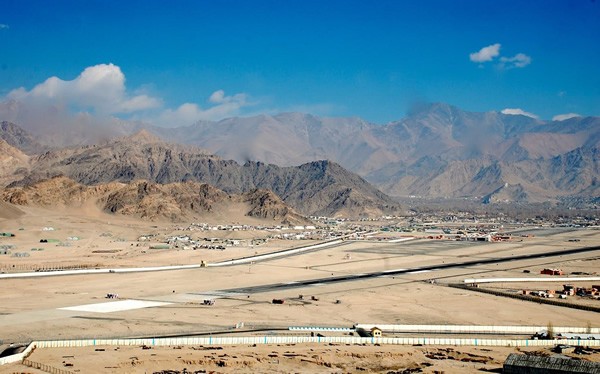 |
| A landscape view of the capital of Ladakh, Leh. |
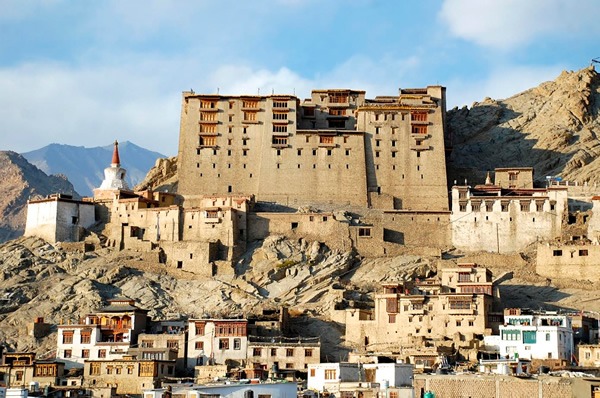 |
| Ancient royal palace towering over Leh. |
High Altitude
Lured by the promise of a major monastic festival with monks performing sacred mask dances, treks in the foothills of the Himalaya with plenty of wildlife spotting and fabulous panoramas, and homestays in traditional, authentic villages just before snow, ice, frozen pipes and power outages will cut off Ladakh’s remote valleys for the rest of the winter, 12 adventurers including myself set foot in Leh.
It is mid-November, the day temperature is just above the freezing point, and a bright sun is welcoming us.
Ladakh immediately takes my breath away, and that is not only caused by the sight of its impressive snow-capped mountains and vast bare-earth land dotted with forts and monasteries, but also by the combination of low oxygen levels and low atmospheric pressure, which causes me to huff and puff at the slightest movement.
Indeed, Ladakh is known as one of most notorious places in the world to be affected by altitude sickness (AMS). So we have been forewarned to give our bodies enough time to adjust to Leh’s altitude of 11,500 feet by slowing down, breathing deeply, and drinking plenty of water to minimize headaches, dizziness, breathlessness, and loss of appetite. Luckily, these symptoms disappear over time, although exercising caution climbing staircases and mountain slopes is necessary.
Monastic Festivals
Throughout Ladakh, the landscape is defined by Buddhist landmarks and sites: stupas in various sizes and shapes, where the faithful meditate, bring offerings, burn incense, and circle around in clockwise direction; rows of single-storey prayer wheels, each of which can be rotated around a rod, every turn being the equivalent of a reading of the prayers enclosed within the metal cylinders; multicolored prayer flags on rooftops, bridges and poles, which are meant to spread their wood-printed mantras through the winds across the land; and above all, the many gompas or monasteries, the pillars of Buddhism. Some of the most important are located in the Indus valley around Leh, including Spittuk, Phyang, Thiksay, Matho, Stakna, and Hemis monasteries.
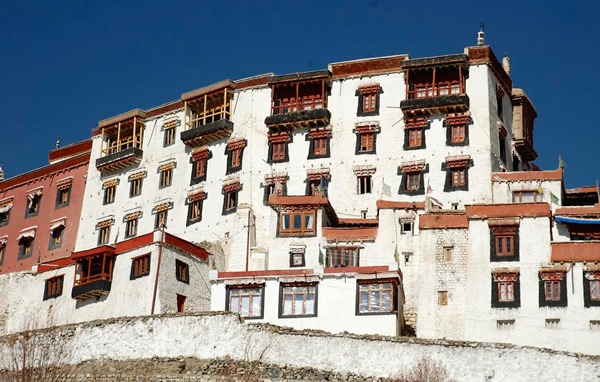 |
| Phyang monastery in the Indus Valley. |
Our stay in Ladakh coincides with the Thiksay Gustor festival, held annually in the courtyard of the 12 storey-high Thiksay monastery, located on a hill overlooking a village of the same name, at about 20 km southwest of Leh. This stunning complex, painted in red, ochre, and white, and built in the early 15th century, is affiliated with the Gelug (Yellow Hat) sect, the largest school of Tibetan Buddhism, of which the Dalai Lama is the head.
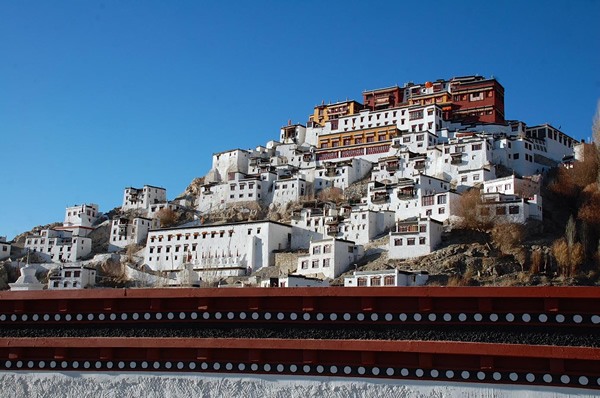 |
| Thiksay monastery. |
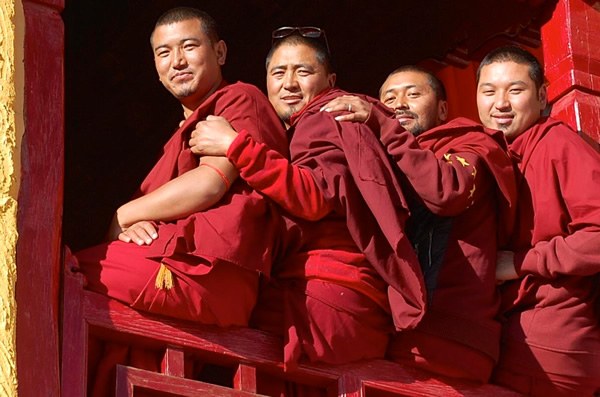 |
| Monks at the Thiksay monastery. |
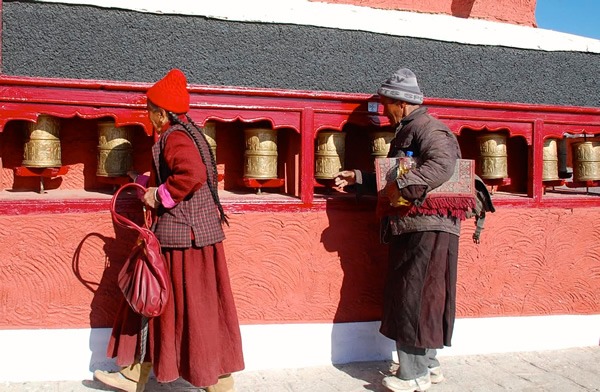 |
| Prayer wheels at Thiksay monastery. |
Practically the only foreigners around, we mingle for two days with friendly Ladakhi worshippers from far and near, who congregate here to observe early morning prayer services, visit temples, socialize at the trade fair at the base of the monastery, venerate the thanka — a huge painted scroll depicting the life of Buddha that is being unfurled and displayed for the occasion — and above all, watch monks, dressed in colorful brocade costumes and geared with paper maché masks, perform sacredly choreographed dances.
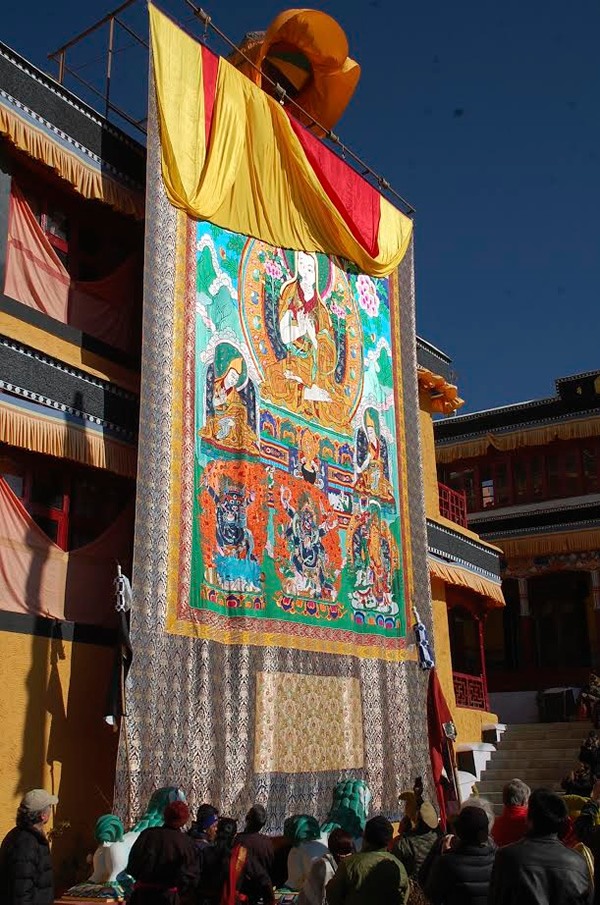 |
| The thanka. |
 |
| Novices watching the thanka being unfurled. |
Supervised by dance masters, and accompanied by a traditional monastic orchestra including cymbals, long horns, trumpets, and a prayer drum to measure the rhythm of the ceremonies, the monks reenact in slow movements the arrival and development of Buddhism, and the triumph of good spirits over evil demons.
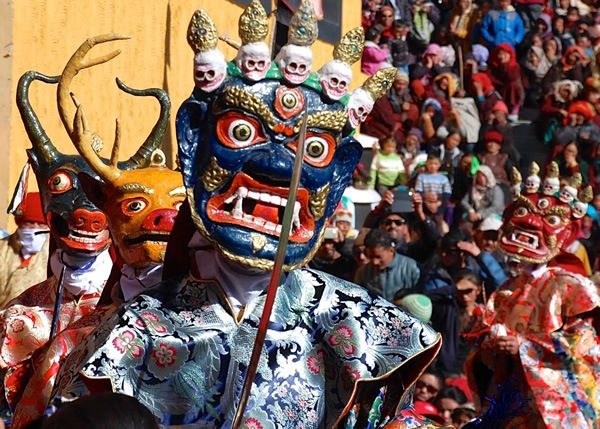 |
| Monks performing choreographed ritual dances to sacred music wearing paper maché masks during the festival at Thiksay. |
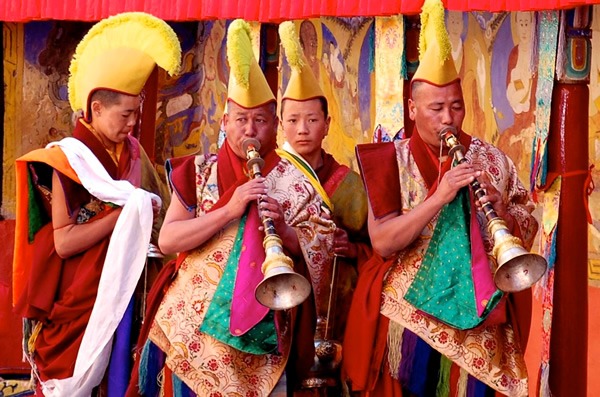 |
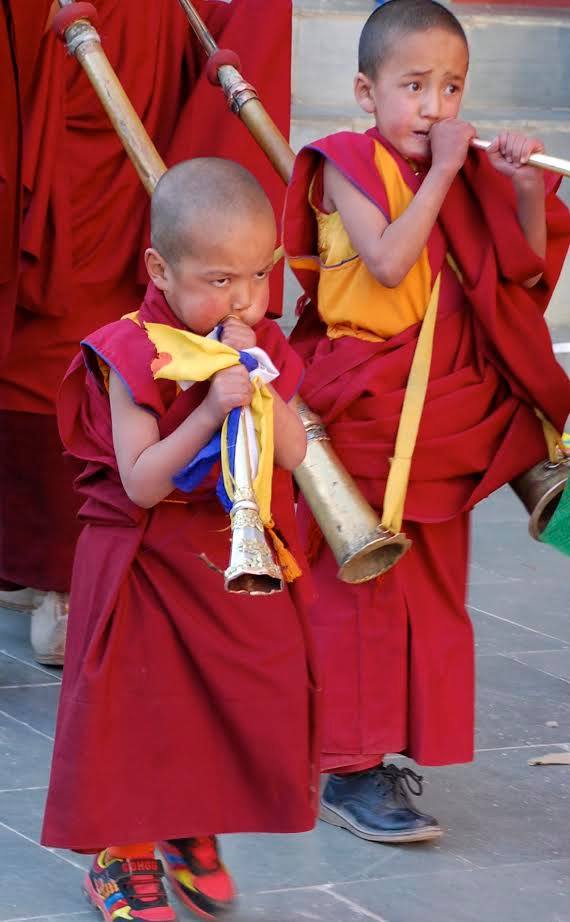 |
| Musicians of all ages play along. |
 |
| Spectators at a festival in Ladakh with hand-held prayer wheels and 108-beaded rosaries in Ladakh.. |
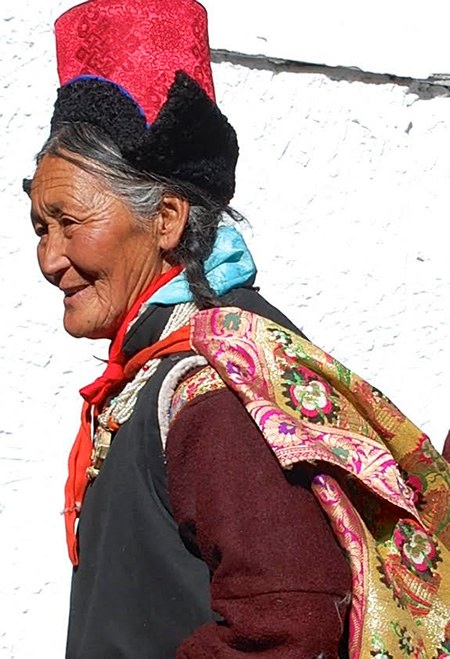 |
| A spectator at the festival. |
During the closing ceremony a sacrificial effigy (torma), made from a mix of butter and flour, is thrown into the flames of a bonfire by the head of the black hat dancers. This act symbolizes not only the victory of good over evil, but also the notion that in the end, nothing in life is permanent.
Trekking
Leaving Leh behind, we travel westwards in 4x4s, accompanied by a small team of cooks, guides, and wild spotters. We drive first along the mighty Indus, then branch off along the side of a gorge above the Zanskar River, well-known for its frozen river expeditions in the midst of winter.
During heavy floods in 2015, the bridge over the Zanskar River at Chilling collapsed, cutting off any road travel to villages on the other side of the river. The only option to reach the Markha valley, the first destination on our trekking itinerary, is by being transported — one by one — in a makeshift breeches buoy, together with our luggage and food. The latter are picked up by a vehicle on the other side, while we continue on foot through the bare hills towards our guesthouse in Skiu village. Amidst hardly any other sounds than those of cattle bells and bleating sheep, we pass here and there a friendly villager, and exchange a cheerful “yulley,” which can be used to express a “hello,” “goodbye,” “please,” and “thank you.”
 |
| Crossing the Zanskar River, one at the time, in a makeshift breeches buoy. |
For a week we hike through a landscape of rivers and valleys, mountains and peaks, monasteries, and hamlets. At the end of our daily treks, we stay in authentic, traditional (farm) guesthouses, made from dried mud bricks, with a flat roof made of beams of poplar stems, crossed with willow branches.
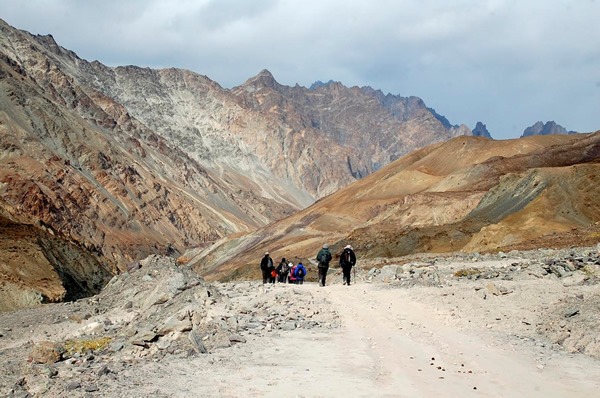 |
| Our small group hiking in the Markha Valley. |
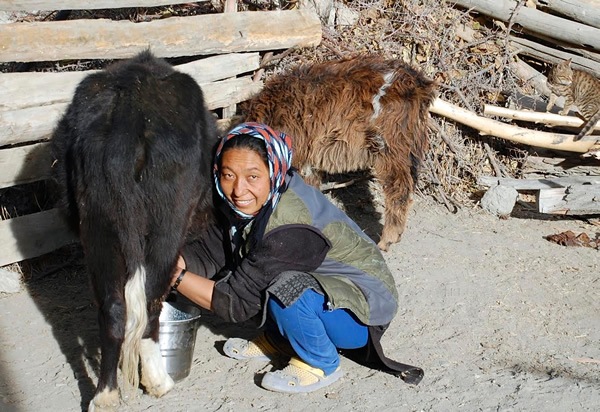 |
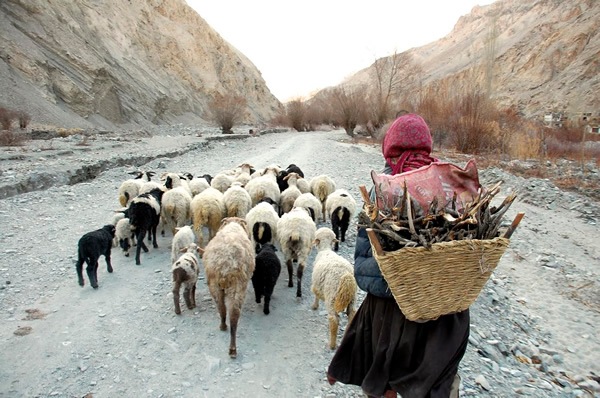 |
| Our hosts in Skiu village. |
Ladakhi Way of Life
The homes are sparsely furnished, but we sleep on good mattresses or even beds and are provided with plenty of blankets and warm water bottles to add extra warmth to our sleeping bags. Toilets are outhouses of the long-drop type (feces are collected and later used to fertilize the land), and in the morning, after a luxurious cup of tea in bed, we each receive a bowl of warm water to “splash” ourselves. There is no running water, electricity can be inconsistent or restricted to just a few hours a day, and WiFi is out of the question.
The kitchens of Ladakhi houses are invariably the most decorated of all rooms, with a mud or metal hearth in the middle of the room serving as a focal point. Since it is the only room with a proper heating source, it also doubles as a guestroom, dining room, and living room. There is ample seating on the ground on colorful carpets and pillows along three walls of the room, with low tables in front. Against the fourth wall, collections of kitchenware including traditional copper and brass pots and pans, are usually proudly displayed.
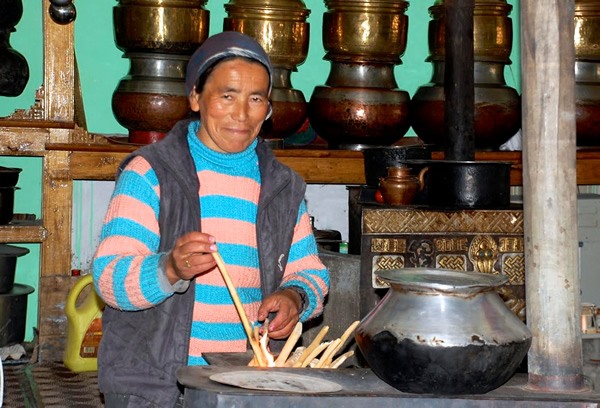 |
| Hostess in the kitchen of her guesthouse in Chilling village. |
Although we have cooks to prepare meals, our hosts bring out gur-gur cha, hot butter tea with salt and boiling milk, accompanied by Ladakhi biscuits such as the roasted barley flour based puli. In the early mornings, they also bake their delicious, thick-crusted khambir, a traditional bread made from whole wheat, baking soda, and water.
Most Ladakhi are subsistence farmers with barley as their main crop. Barley has a relatively short ripening process, so is suitable for higher altitudes. Cattle still provide the main power for plowing. The chief domesticated animals are sheep, goats, donkeys, horses, and yaks. For centuries, yaks have not only been used to carry burdens at high altitude, but also for their milk, wool, meat, and dried droppings (fuel!).
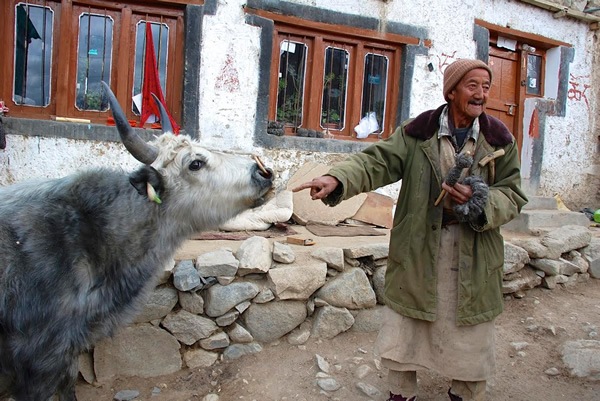 |
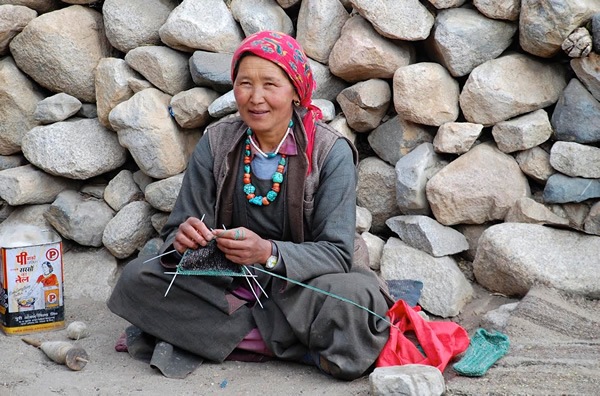 |
| Guesthouse hosts in Ullay village, processing wool from their yaks. |
Villages in the remote Ladakhi valleys form a well-organized system. Each village has a headman, chosen by rotation, who has the power to settle disputes, control the distribution of water (summer snow-melt and glacier-melt are the only sources), and see to it that villagers support each other communally. Two or more families share agricultural labors, have a common herdsman taking their cattle to pastures, and perform important rituals together such as births, weddings, and funerals.
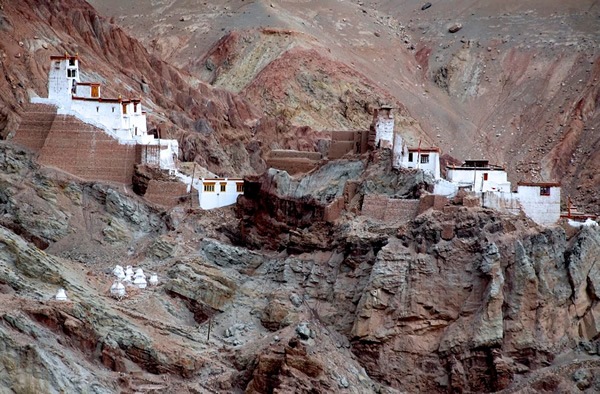 |
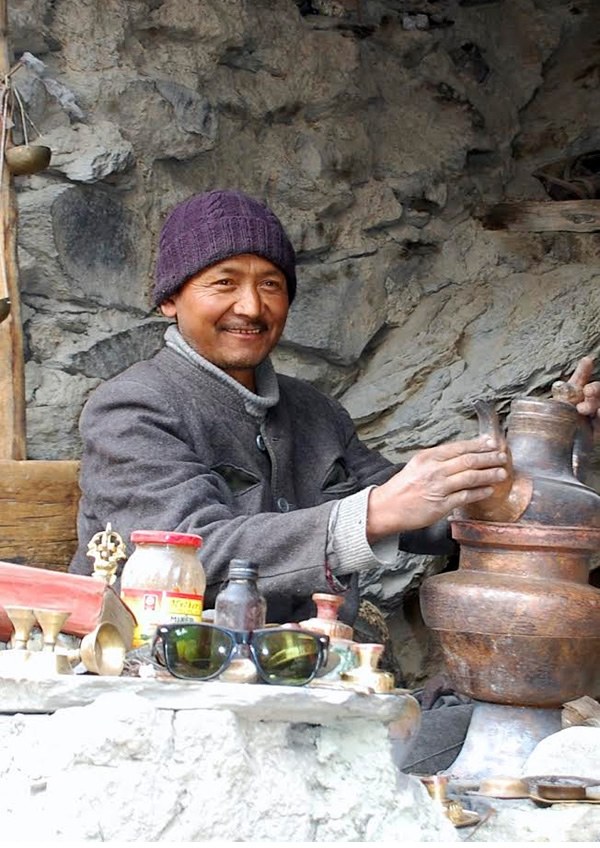 |
| Chilling is a coppersmith town, and here is a local at work. |
Wild Animal Spotting
Before embarking on our daily treks, our guides are already out with their powerful telescopes to see if they can spot any wild animals or their tracks. Most of the wild animals living here are endangered species, and the shan, or snow leopard, is the rarest and most elusive. Beyond zoos, not many humans have been able to spot a snow leopard because of their camouflage coloration against rock and snow, as well as their solitary, nocturnal habits.
The snow leopard’s main prey is the blue sheep, which comes down to lower altitudes to seek some warmth once winter sets in. As a consequence, the snow leopard usually follows and become more visible to humans as well. Villagers, who would have set traps in earlier times to protect their cattle, can nowadays contact the local wildlife department to report any loss of cattle caused by snow leopards and claim compensation.
Since some amazing film footage of snow leopards was recently shot in Ladakh, many an adventurer harbors the wish to become one of the few on our planet to witness this secretive creature in the wild. In spite of our many attempts, we are unfortunately not among these happy few, but the sightings of herds of urials, ibex, and blue sheep, as well as lammergeiers are highly rewarding too. And are the fresh tracks on one of the mountain paths around Ullay not those of a wolf just passing by…?
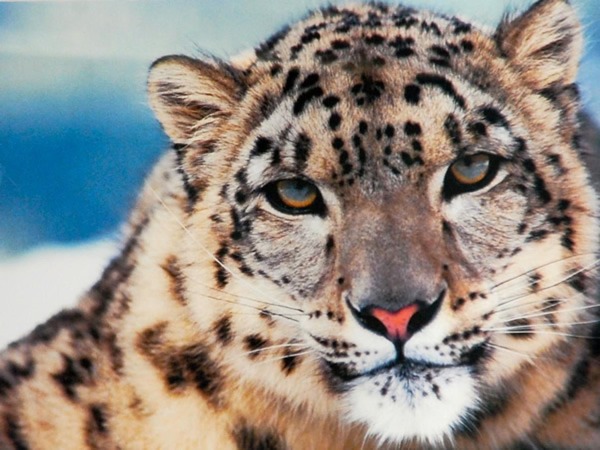 |
| The elusive snow leopard (courtesy of Ladakh Ecotourism Centre). |
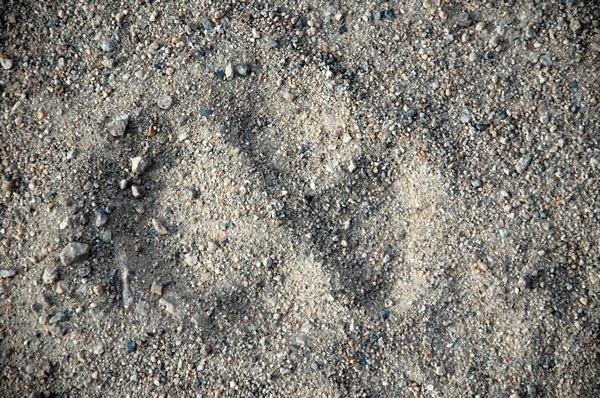 |
| Could there be a wolf around the corner? |
Responsible Tourism
The 15-day trip is organized by Exodus Travels in conjunction with their local partner Welcome Travels in New Delhi. The journey is led by longtime expedition leader and Exodus’ Himalaya Base Manager Valerie Parkinson, the first British woman to reach the summit of the 8163m high Manaslu at the Nepal-Tibet border, in 2008. All local guides are trained in Responsible Tourism in order to protect the natural environment of Ladakh and help its local communities thrive without compromising their way of life.
Apart from leading expeditions for many years, Valerie has also been instrumental in setting up various Exodus’ Responsible Travel Projects in Nepal and Ladakh. These include expanding village schools, installing solar cookers in teahouses around Mount Everest, supporting a donkey sanctuary in Leh, connecting a remote village to a local Hydropower plant, establishing an eco-café and handicraft shop run by local women, and last but not least, providing much-needed support in the aftermath of the disastrous 2015 earthquake in Nepal.
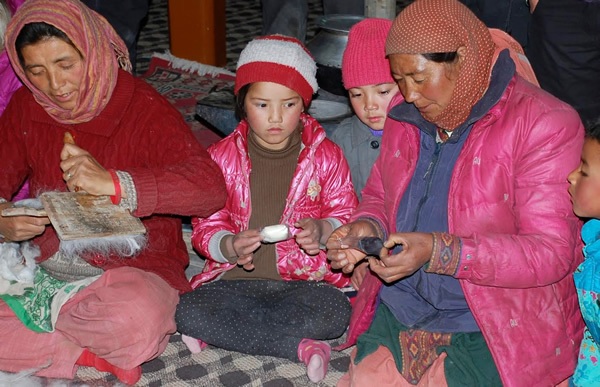 |
| A workshop to teach villagers about working with felt, led by Valerie Parkinson. |
Lies Ouwerkerk is originally from Amsterdam, The Netherlands, and currently lives in Montreal, Canada. Previously a columnist for The Sherbrooke Record, she is presently a freelance writer and photographer for various travel magazines.
|
